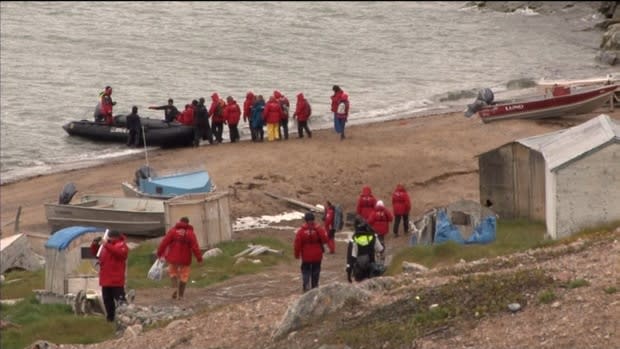New fee for Nunavut tourists intended to benefit Inuit
The Qikiqtani Inuit Organization (QIA) has implemented a new fee system for tourists who visit Inuit-owned lands in the Qikiqtaaluk Region.
Under the new system, tour operators will be charged $150 per plane landing, and $100 per helicopter landing. Commercial guests will pay $50 per day to camp on Inuit-owned land, and $25 per day to visit for less than six hours.
Half the money will go to the local hunting and trapping organization closest to the Inuit-owned land in question, and the other half goes to the QIA to cover fee system administration costs.

The president of QIA calls the fees "trailblazing."
"We're a designated Inuit organization that administers Inuit owned lands," PJ Akeeagok said. "We feel this is the right approach to ensure the true benefits stay with Inuit."
QIA's board has long discussed how to ensure Inuit benefit from the increasing number of tourists who visit Qikiqtaaluk, Akeeagok said. The region includes the Northwest Passage, and gets the most cruise ship traffic in Nunavut.
'Pretty reasonable': tour operator
Jason Matthews owns Wild Alaska Travel, a company that operates mostly out of Kaktovik, Alaska, taking tourists on boat rides to see polar bears. He's been in the industry for 25 years, and says QIA's fees are, "pretty reasonable."
The fees don't affect Matthews' business, but as a tour operator who works with Iñupiat in the Arctic, he supports the fees in principal.
"I think it's great." Matthews said. "I think there should be some sort of monetary incentive for locals to open their community up to people."
Kaktovik is an Iñupiat village of around 300 people. Matthews says his company does home stays in the community, and the boat tour captain is an Iñupiat local.

"Whenever I'll talk with people about tourism the villagers there [ask] 'what's in it for us?'" Matthews said.
Matthews said the fees are expensive, but reasonable. He said they will set the stage to encourage reasonable tourism as climate change allows more and more people to fulfil their dreams to visit the Arctic.
"I think it's a way of really sort of being selective of who comes in your communities," Matthews says. "People who really want to come into your communities will pay those prices."
Fees don't address all concerns
Akeeagok said the fees aren't meant to deter visitors, but since the fees are newly implemented he has no idea how they will affect how people decide to visit Qikiqtaaluk — maybe they'll try to visit Crown land instead, he said.
There's also no way to know how much money this will bring to local hunting and trapping organizations.
And, no matter the amount of money the fees bring in, Akeeagok said an ongoing concern is whether or not money will make up for how cruise ships, planes, visitors and the waste they leave behind, affect the water and animals in the region.
Akeeagok does say that on top of the fee, there is still a strict application process for any company that wants to bring people onto Inuit-owned land, and that it's up to the discretion of regional clerks to deny any application.
A further point of consideration that Akeeagok says continues to be discussed by QIA is how to mitigate the effects, and benefit from, cruise ships that pass by communities in Qikiqtaaluk without landing.

"Obviously we take very seriously the issue of wildlife being disturbed or artifacts being disturbed," Akeeagok says.
Any issue that affects Inuit livelihood in Qikiqtaaluk is under the purview of QIA, Akeeagok said.
"Climate change is opening up the possibilities available through tourism," he says. "I'm really excited about the policy … it's the first of its kind in terms of the distribution of the benefits, and it really sets out a foundation moving forward in terms of QIA administering Inuit-owned lands."


